Meet Kalipada Pahan, professor of neurology at Rush University Medical College in Chicago, USA. He cured many diseases: Alzheimer’s, Parkinson’s, multiple sclerosis, cancer, even COVID-19. Not all of it with cinnamon, some with patented saltwater! But all with massive dishonesty, where countless mice, and even monkeys, suffered for bad science.
I wrote about Pahan briefly in earlier Friday Shorts. In July 2023, he was celebrated by Rush University Medical Center in a press release:
“RUSH researchers recently discovered that a muscle-building supplement called beta-hydroxy beta-methylbutyrate, also called HMB, may help protect memory, reduce plaques and ultimately help prevent the progression of Alzheimer’s disease. […]
“This may be one of the safest and the easiest approaches to halt disease progression and protect memory in Alzheimer’s disease patients,” said Kalipada Pahan”
The study Paidi et al 2023 declared, like all of Pahan’s papers:
“The authors declare no competing interests.”

Like much else about Pahan’s science, that was not honest. He is member of the Scientific Advisory Board of the Hong Kong-based company Forest Hills Lab, which “is engaged in therapeutic drug development for highly unmet medical conditions in the neurodegenerative disease areas, such as Parkinson’s and Alzheimer’s disease.” Until recently, Pahan used to be advisor for Revalesio Corp, a US biotech specialising in anti-inflammatory drugs. Pahan also owns a startup named Pahan Therapeutics (currently , its motto: “Finding the cure to cancer and autoimmune disorders“. Officially, Pahan’s wife Swarupa Pahan is president, her husband is the only board member. The company’s website is defunct, but there are backups, here from 2018.

I wrote to Pahan, and he explained his hidden Conflicts of Interests. In his version, Forest Hills Lab and Revalesio gave research grants to Rush, but listed him without his knowledge as their board member. Pahan also said:
“Rush can find out whether I got a penny for being in their Scientific Advisory Board. Since I do not have financial interest, I did not disclose it in the papers. […]
Pahan Therapeutics was formed for licensing couple of technologies from Rush. However, Pahan Therapeutics could not raise any fund and therefore, we have closed it and informed this to Rush. Since it does not exist, we do not have any conflict of interests.
Due to these reasons, we will not submit any correction/erratum for this issue.“
Yogeshwer Shukla’s toxic career of Ayurvedic infusions
Professor Shukla is a bigwig in Indian toxicology because he uses fresh fruit, tea and curry spices to cure cancer. For maximum effect, his lab resorts to fabricating data in Photoshop.
But Pahan main interest is cinnamon. In this 2015 peer-reviewed garbage he authored with his daughter Priyanka Pahan (a student at Northwestern University), he claimed that cinnamon cured Parkinson’s disease (“we have seen that Ceylon cinnamon is much more pure than Chinese cinnamon, as the latter contains coumarin“). The next year, the Rush University professor claimed that cinnamon also improved learning (Modi et al 2016): “This would be one of the safest and the easiest approaches to convert poor learners to good learners”.
Here are two relevant studies – one postulated cinnamon buns as a cure for Parkinson’s and Lewy bodies dementia, another, in Bentham, pronounced cinnamon as the cure for Alzheimer’s.


(left): Sumita Raha, Debashis Dutta , Avik Roy , Kalipada Pahan Reduction of Lewy Body Pathology by Oral Cinnamon Journal of Neuroimmune Pharmacology (2020) doi: 10.1007/s11481-020-09955-2
As you see, cinnamon’s medicinal effect only works with image duplication. In this study, mice had their skulls drilled and their brains damaged so that Pahan could use fudged images to claim that cinnamon has healing powers:
Suresh B. Rangasamy , Sumita Raha , Sridevi Dasarathy , Kalipada Pahan Sodium Benzoate, a Metabolite of Cinnamon and a Food Additive, Improves Cognitive Functions in Mice after Controlled Cortical Impact Injury International Journal of Molecular Sciences (2021) doi: 10.3390/ijms23010192
Dysdera arabisenen: “Fig 2: Overlapping images represent different experimental groups or brain regions.”

In the same MDPI journal, again mice subjected to same brain damage, but to push a different food additive as therapy:
Suresh B. Rangasamy , Jit Poddar , Kalipada Pahan Protection of Mice from Controlled Cortical Impact Injury by Food Additive Glyceryl Tribenzoate International Journal of Molecular Sciences (2023) doi: 10.3390/ijms24032083

Of additional concern: The areas marked with bright red are different between the panels that look otherwise identical.”
But back to cinnamon. This Parkinson’s cure, like many other Pahan papers on PubPeer (currently almost 30), was flagged by the pseudonymous member of our team, Dysdera arabisenen:
Suresh B. Rangasamy, Sridevi Dasarathi , Aparna Nutakki , Shreya Mukherjee , Rohith Nellivalasa , Kalipada Pahan Stimulation of Dopamine Production by Sodium Benzoate, a Metabolite of Cinnamon and a Food Additive Journal of Alzheimer s Disease Reports (2021) doi: 10.3233/adr-210001

Pahan explained to me:
“Such a mistake does not affect the research results and conclusion of the article. For example, we have published that cinnamon is exhibiting neuroprotection in animal models of Parkinson’s disease and multiple sclerosis. This finding is not affected by such a mistake.”
On PubPeer, Pahan commented in February 2024:
“We have submitted correction/erratum for this to the journal. Thank you.“
He made a similar announcement of several other PubPeer threads, often also sending his first authors to reassure readers about unintended mistakes which will be corrected soon. In fact, already in 2017 Pahan issued a Correction for a groundbreaking study where he claimed to cure Alzheimer’s in mice by injecting them with “0.9% saline solution containing oxygenated nanobubbles“, i.e. saltwater, into their bellies:
Khushbu K. Modi , Arundhati Jana , Supurna Ghosh , Richard Watson , Kalipada Pahan A physically-modified saline suppresses neuronal apoptosis, attenuates tau phosphorylation and protects memory in an animal model of Alzheimer’s disease PLoS ONE (2014) doi: 10.1371/journal.pone.0103606
“In Fig 9B, the images in row Tg-FADX are incorrectly duplicates of the images in row Tg+NS, due to an error during preparation of the figure. […] The authors confirm that these changes do not alter their findings.”

This nanostructured saltwater or “Oxygen nanobubbles” or RNS60 is marketed by Revalesio, a biotech which funded the study yet with which Pahan, as reminder, has less than zero conflict of interests. His coauthors Richard Watson and Supurna Ghosh are Revalesio’s employees, the latter is Vice-President. According to Alzheimer’s Drug Discovery Foundation:
“Putative neuroprotective properties of RNS60 have been published by only one lab – K Pahan at Rush University, although unpublished confidential reports from a second lab at Harvard appear to confirm some details.”
Derek Lowe debunked Revalesio’s nano-saltwater in a 2014 blogpost, where he also quoted from a now-deleted press release:
““The impact of RNS60 on Alzheimer’s disease as outlined in our studies presents new opportunities for hope and deeper research in treating a disease that currently cannot be prevented, cured or even successfully managed,” said Dr. Kalipada Pahan, professor of neurological sciences, biochemistry and pharmacology and the Floyd A. Davis, M.D., endowed chair of neurology at the Rush University Medical Center. “Our findings sparked tremendous excitement for RNS60, identifying an opportunity for advanced research to develop a novel treatment to help the rapidly increasing number of Alzheimer’s disease and dementia patients.”
Pahan also cured Parkinson’s with aspirin. For example this, again with his clever daughter Priyanka:
Suresh B. Rangasamy , Sridevi Dasarathi , Priyanka Pahan , Malabendu Jana , Kalipada Pahan Low-Dose Aspirin Upregulates Tyrosine Hydroxylase and Increases Dopamine Production in Dopaminergic Neurons: Implications for Parkinson’s Disease Journal of Neuroimmune Pharmacology (2019) doi: 10.1007/s11481-018-9808-3

In some studies, Pahan injected mice with the neurotoxin 1-methyl-4-phenyl-1,2,3,6-tetrahydropyridine (MPTP) to turn them into “Parkinson’s model”. The mouse suffering was real, the published results were not:
Goutam Chandra , Suresh B. Rangasamy , Avik Roy , Jeffrey H. Kordower , Kalipada Pahan Neutralization of RANTES and Eotaxin Prevents the Loss of Dopaminergic Neurons in a Mouse Model of Parkinson Disease Journal of Biological Chemistry (2016) doi: 10.1074/jbc.m116.714824
“Fig 8: Overlapping images represent different groups of mice.”

In the next study, mice were lucky, they only had to run the treadmill before being killed, the results then adjusted to Pahan’s expectations:
Suresh B. Rangasamy , Malabendu Jana , Sridevi Dasarathi , Madhuchhanda Kundu , Kalipada Pahan Treadmill workout activates PPARα in the hippocampus to upregulate ADAM10, decrease plaques and improve cognitive functions in 5XFAD mouse model of Alzheimer’s disease Brain Behavior and Immunity (2023) doi: 10.1016/j.bbi.2023.01.009


Soon, Elisabeth Bik joined Dysdera arabisenen‘s treasure hunt, here is one example, a cure for Alzheimer’s with retinoic acid and gemfibrozil:
Sumita Raha , Arunava Ghosh , Debashis Dutta , Dhruv R. Patel , Kalipada Pahan Activation of PPARα enhances astroglial uptake and degradation of β-amyloid Science Signaling (2021) doi: 10.1126/scisignal.abg4747



Pink boxes: The TFEB/Non-Tg and the LAMP2/Non-Tg panels appear to overlap.
Note that in both the green signal as well as the red signal, the panels are not exactly the same. Some elements might have been altered.”
At some point Pahan understood that spices like cinnamon are not patentable, so he started to push stuff on behalf of Big Pharma (while never receiving a penny, of course!). Here again is the same blood lipid reduction drug gemfibrozil, this time deployed as cure for Parkinson’s:
Carl G. Gottschalk , Malabendu Jana , Avik Roy , Dhruv R. Patel , Kalipada Pahan Gemfibrozil Protects Dopaminergic Neurons in a Mouse Model of Parkinson’s Disease via PPARα-Dependent Astrocytic GDNF Pathway Journal of Neuroscience (2021) doi: 10.1523/jneurosci.3018-19.2021

Another case of Bik helping Dysdera, where Pahan, totally free of any commercial conflict of interests, pushes another blood fat reduction drug, fenofibrate, as the cure for Parkinson’s and Lewy bodies dementia:
Debashis Dutta, Ramesh Kumar Paidi , Sumita Raha , Avik Roy , Sujyoti Chandra , Kalipada Pahan Treadmill exercise reduces α-synuclein spreading via PPARα Cell Reports (2022) doi: 10.1016/j.celrep.2022.111058


I have only marked the Merged panels and the inset.
These appear to be different experiments, because in Figure S1A the A53T mice were injected with PBS into their brain, while Figure 4G is described as just testing two different mouse strains, without any injection.”
This mouse duplication, according to Pahan’s coauthor was never fraud, but “an honest mistake and it happened while processing images in the powerpoint“:
Swapna Bera , Rajiv K. Kar , Susanta Mondal , Kalipada Pahan, Anirban Bhunia Structural Elucidation of the Cell-Penetrating Penetratin Peptide in Model Membranes at the Atomic Level: Probing Hydrophobic Interactions in the Blood–Brain Barrier Biochemistry (2016) doi: 10.1021/acs.biochem.6b00518

And here Bik found out that Pahan not only published trash Alzheimer’s and Parkinson’s cures, but also trash cancer cures:
Madhuchhanda Kundu , Sumita Raha , Avik Roy , Kalipada Pahan Regression of Triple-Negative Breast Cancer in a Patient-Derived Xenograft Mouse Model by Monoclonal Antibodies against IL-12 p40 Monomer Cells (2022) doi: 10.3390/cells11020259


Purple boxes: One of the control tumors (of a female mouse injected with breast cancer cells) looks remarkably similar to a control tumor in Kundu et al., PNAS (2017), DOI: 10.1073/pnas.1705536114, where it represents a male mouse injected with prostate cancer cells.”

Particularly disgusting: Pahan used macaques to produce likely falsified science. 15 female rhesus monkeys were tortured by injections of the neurotoxin MPTP into their carotid artery, later on with injections of whatever crap Pahan planned to establish as Parkinson’s cure, then bled to death, their brains removed and studied. This is the result, where an image was duplicated and shifted:
Susanta Mondal, Avik Roy, Arundhati Jana , Sankar Ghosh , Jeffrey H Kordower, Kalipada Pahan Testing NF-κB-based therapy in hemiparkinsonian monkeys Journal of Neuroimmune Pharmacology (2012) doi: 10.1007/s11481-012-9377-9
Dysdera arabisenen: “Fig 3: Overlapping images represent different treatment groups”

Pahan is ready to act on the evidence of data manipulation on PubPeer, as he wrote to me:
“I was also shocked to see all these, which came mainly in the last two weeks. Then I started looking at the erratums/corrections in the PubMed submitted by different scientists and found that all our PubPeer citations can be taken care of by submitting erratums and corrections. In most of the citations, you will find that same image has been given in two places. Although I am not defending our mistakes at all, these are part of human errors. This is because in some papers, when there are more than 100 individual images, such a mistake may happen.“
Coronil and other peer-reviewed Ayurvedic scams
“ऑथर ने किसी हित संघर्ष की घोषणा नहीं की है”
This genius even cured COVID-19. In October 2021, Rush University issued this press release:
“Scientists at the Rush University Medical Center (Chicago) have successfully used a small molecule called SPIDAR to reverse cytokine storm, reduce fever, protect lungs, and improve heart function in a mouse model of COVID-19. […]
“This could be a new approach to prevent SARS-CoV-2 infection and protect COVID-19 patients from breathing problems and cardiac issues,” said Kalipada Pahan, PhD, the Floyd A. Davis Professor of Neurology at Rush and a Research Career Scientist at the Jesse Brown VA Medical Center. […]
“Since SARS-CoV-2 binds to angiotensin-converting enzyme 2 (ACE2) for entering into the cells, we have designed a small peptide corresponding to the Spike S1-Interacting Domain of ACE2 Receptor (SPIDAR) to inhibit the binding of virus with ACE-2”, Dr. Pahan said. […]
“Interestingly, after intranasal treatment, SPIDAR reduces fever, protects lungs, normalizes heart function, and enhances locomotor activities in a mouse model of COVID-19,” Dr. Pahan said.”
Of course that was all bullshit and based of fudged data:
Ramesh K Paidi, Malabendu Jana, Rama K Mishra , Debashis Dutta, Kalipada Pahan Selective Inhibition of the Interaction between SARS-CoV-2 Spike S1 and ACE2 by SPIDAR Peptide Induces Anti-Inflammatory Therapeutic Responses The Journal of Immunology (2021) doi: 10.4049/jimmunol.2100144

Just don’t waste your time complaining to the society-published Journal of Immunology. They hate whistleblowers and love fraudsters there.
How Andrea Cerutti molested and defiled Journal of Immunology
Spain is where dishonest research gets rewarded, with awards, grants and media fame. No wonder the New York-based immunologist Andrea Cerutti opened a second lab in Barcelona.
Which makes this all even more demented, is that in December 2022, Pahan announced in MDPI (Sheinin et al 2022) a cure for cancer, which is… a COVID-19 infection!
“Intranasal spike S1 protein could be used for late-stage lung cancer when there’s no other therapy to stop the progression.”
Rush University wet themselves with excitement and headlined their press release: “Could COVID-19 Hold a Cancer Cure?“
“The discovery raises the possibility that the pandemic that has afflicted the globe for three years might also yield a treatment for lung cancer, and perhaps other cancers as well. […]
“It is always important to find mechanisms to stimulate cancer cell death and stop the progression of cancer,” said Kalipada Pahan, PhD […] He adds that anecdotal cases of people with lung cancer that improved after they developed and recovered from COVID-19 also suggest the coronavirus’ potential as an unlikely ally against cancer. […] “Intranasal spike S1 protein could be used for late-stage lung cancer when there’s no other therapy to stop the progression.” Pahan and his team currently are seeking partners to study the use of the spike protein in clinical trials of human patients with lung cancer.”
Luckily, the pandemic fizzled out before that clown was allowed to experiment on cancer patients with that nonsense.

But elsewhere, Pahan experimented on people. This study used many mice, but also the blood from Multiple Sclerosis (MS) patients:
Susanta Mondal , Madhuchhanda Kundu , Malabendu Jana , Avik Roy , Suresh B Rangasamy , Khushbu K Modi , Jennillee Wallace , Yasmeen A Albalawi , Roumen Balabanov , Kalipada Pahan IL-12 p40 monomer is different from other IL-12 family members to selectively inhibit IL-12Rβ1 internalization and suppress EAE Proceedings of the National Academy of Sciences (2020) doi: 10.1073/pnas.2000653117
The mouse data appears to be falsified:



Red boxes: The EAE panel looks remarkably similar to the EAE panel in Figure 4G of Mondal et al., PLOS ONE (2015), DOI: 10.1371/journal.pone.0116566
Pink boxes: The EAE+p40 panel looks remarkably similar to the Control panel in Figure 5A of Mondal et al., Journal of Clinical and Cellular Immunology (2017), DOI: 10.4172/2155-9899.1000488″

Orange boxes: The CIA panel looks remarkably similar to the CIA+mTIDM panel in Rangasamy et al., J Clinical Investigation (2018), DOI: 10.1172/JCI96209″

I obtained Dysdera arabisenen‘s original dossier on Pahan’s pseudoscience, and that dossier also reports irregularities in the clinical data from MS patients in that and in another paper. Certain numbers keep repeating, inside this study and across another, which is rather unlikely if that was real unadulterated data:
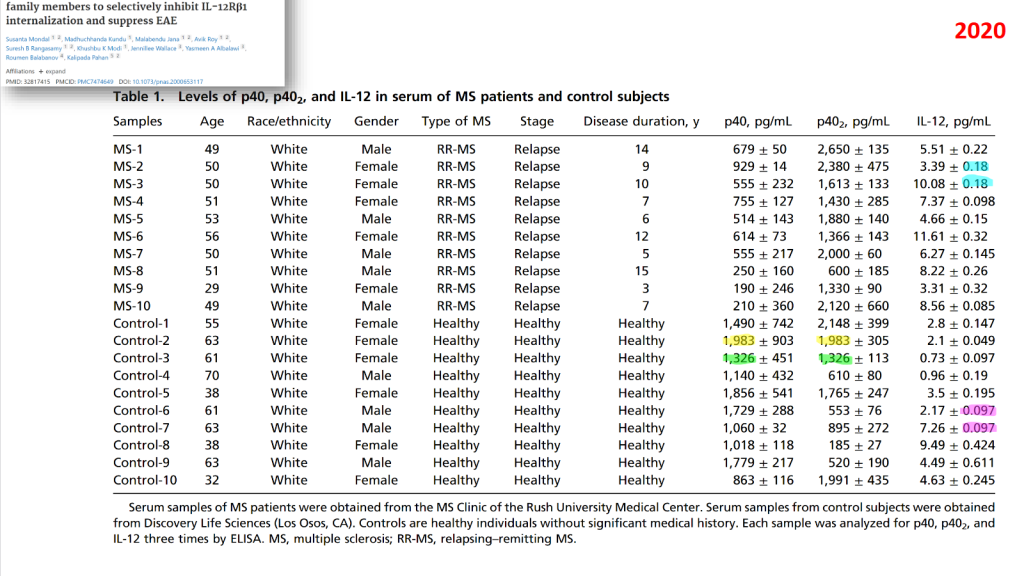
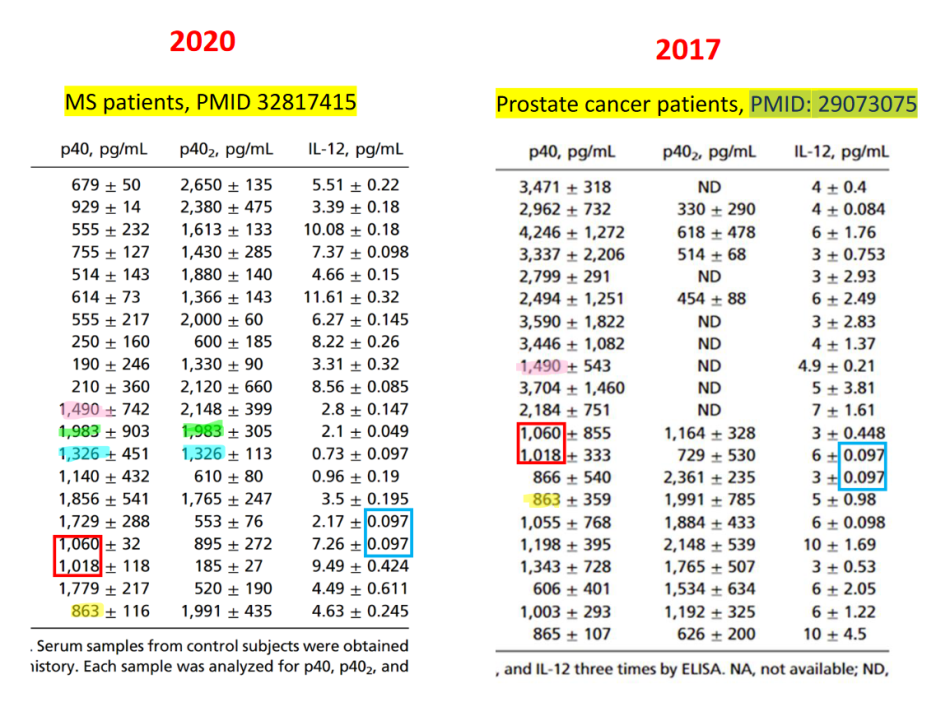
Here is this other paper from 2017, it used the blood from patients with prostate cancer and also contains forged mouse data:
Madhuchhanda Kundu , Avik Roy , Kalipada Pahan Selective neutralization of IL-12 p40 monomer induces death in prostate cancer cells via IL-12-IFN-γ Proceedings of the National Academy of Sciences (2017) doi: 10.1073/pnas.1705536114

Bik: “Pink boxes: Two of the p40 mAb tumors look remarkably similar to each other, albeit shown at different sizes and color saturation.
Blue boxes: One of the p40 mAb+IgG tumors looks remarkably similar to one of the p40 mAb+IL-12 Ab tumors, but is shown at a very different size.”
A similar problem in another paper, where Pahan used blood from Parkinson’s patients:
Debashis Dutta , Madhuchhanda Kundu , Susanta Mondal , Avik Roy , Samantha Ruehl , Deborah A. Hall , Kalipada Pahan RANTES-induced invasion of Th17 cells into substantia nigra potentiates dopaminergic cell loss in MPTP mouse model of Parkinson’s disease Neurobiology of Disease (2019) doi: 10.1016/j.nbd.2019.104575
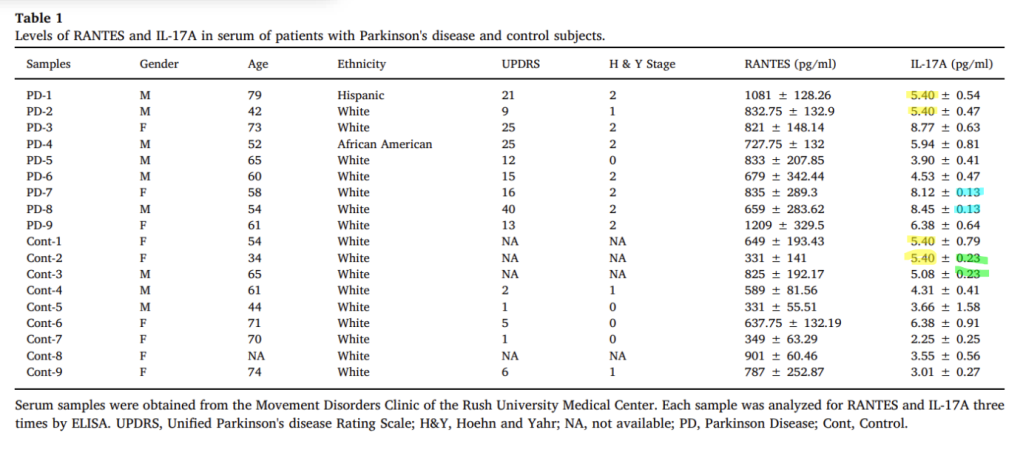
Some of the oldest PubPeer evidence, from October 2022, stems from the whistleblower Paul S Brookes. Rememberer the nanofabricated saltwater? This Revalesio study with RNS60 was already corrected in 2018 because “The Figure 3, 4, 5 legends have been misplaced“:
Susanta Mondal , Suresh B. Rangasamy , Supurna Ghosh , Richard L. Watson , Kalipada Pahan Nebulization of RNS60, a Physically-Modified Saline, Attenuates the Adoptive Transfer of Experimental Allergic Encephalomyelitis in Mice: Implications for Multiple Sclerosis Therapy Neurochemical Research (2017) doi: 10.1007/s11064-017-2214-z

And another one with Revalesio’s magic saltwater against MS, also flagged by Brookes:
Susanta Mondal , Jeffrey A. Martinson , Supurna Ghosh , Richard Watson , Kalipada Pahan Protection of Tregs, suppression of Th1 and Th17 cells, and amelioration of experimental allergic encephalomyelitis by a physically-modified saline PLoS ONE (2012) doi: 10.1371/journal.pone.0051869

For this project, Revalesio Corp even issued a press release:
“These results highlight a novel immunomodulatory role of sa and suggest that this unique therapeutic may yield new treatment options for MS. Revalesio is preparing to test RNS60 in a Phase II MS clinical trial at Mt. Sinai Hospital in New York.”
Ten years ago, RNS60 cured Parkinson’s – there was a paper by Pahan (Khasnavis et al 2014) and a press release by Revalesio. In 2020, Pahan and his Revalesio colleague Ghosh jointly proved that nano-saltwater protects from brain injury (Rangasamy et al 2020). Revalesio eventually proved that RNS60 cures all neurological disorders, and there were even phase 2 clinical trials, here is a recent one on ischemic stroke. Remidns me somewhat of Cassava.
Cassava fraud and Alzheimer’s capitalism
“even Theranos didn’t submit fake data to FDA”
As for Pahan, the man who never took a penny from pharma biotechs: there is more of his trash on PubPeer. All this phony nonsense has been sponsored for years by NIH, Veterans Affairs and various charities. And YOUR grant application was just rejected.
Pahan informed me of his plans for the future:
“…we have already started submitting corrections/erratums to the journals and you will see that from our response in the PubPeer. Within the next 3-4 weeks, we will be able to take care of all the citations.
Again, I must thank you and the PubPeer for opening my eyes because at this stage of my career, I do not directly work in the lab. In the naked eyes, it is also difficult to find such a problem in images. Therefore, to avoid such embarrassing events in our lab in the future, a few days back, I have purchased the AI-powered Proofig software to check image duplication before submitting a manuscript. I am glad to mention that it is working successfully.“
Proofig – the Kolodkin-Gal family business
“Don’t let online controversies and aggressive blogs easily ruin everything you’ve worked for to build your reputation […] Whether the image issue is innocent or intentional, the outcome is still the same. Bloggers will attack that publication with image issues, which will damage your reputation and may even lead to a costly investigation. We are…
Rush University’s research integrity offers refused communication. I guess they accept Pahan’s explanations. That’s what eating too much cinnamon does to your brain.
I thank all my donors for supporting my journalism. You can be one of them!
Make a one-time donation:
I thank all my donors for supporting my journalism. You can be one of them!
Make a monthly donation:
Choose an amount
Or enter a custom amount
Your contribution is appreciated.
Your contribution is appreciated.
DonateDonate monthly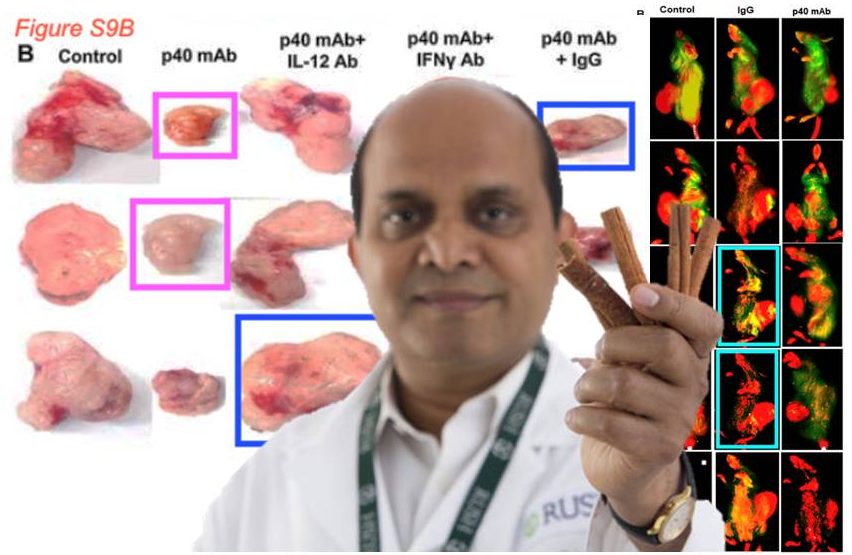




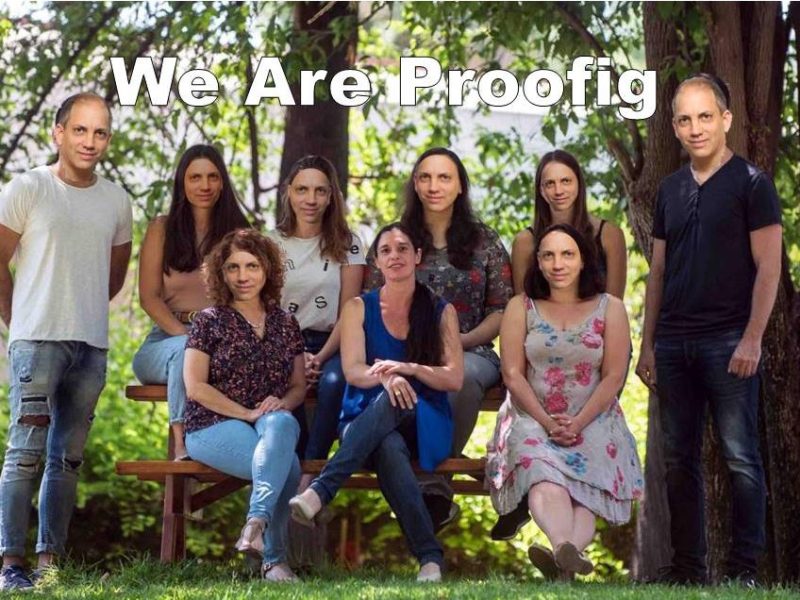

If they were thinking ahead they’d boil a stick of cinammon in salt water, zap it in a sonicator for a bit and they’d probably have a cure for death.
On a positive note, at least from 2017 to 2020 Pahan and colleagues got a better handle on how to express significant figures (the 2017 IL-12 column).
More seriously, that is disgraceful, particularly the cost in animal suffering.
LikeLiked by 1 person
Great work 👍 Glad Proofig has come to the rescue 😂
LikeLiked by 1 person
I see a great future for Proofig. Every fraudster will now submit a Proofig report of purity with their manuscript, so whatever you lot may find later on will be disregarded as slander.
Dror Kolodkin-Gal will become so rich he will buy his wife a professorship in Harvard. Nay, a whole institute.
LikeLike
I think there is someone pretending to be you on Twitter
@LeonidSchneide1
LikeLike
There used to be more than one. Even before Musk and before I was banned, Twitter informed me that it was I who was the imposter.
LikeLike
Elisabeth Bik used Proofig on this!



Timothy F. Musial , Elizabeth Molina-Campos , Linda A. Bean , Natividad Ybarra , Ronen Borenstein , Matthew L. Russo , Eric W. Buss , Daniel Justus , Krystina M. Neuman , Gelique D. Ayala , Sheila A. Mullen , Yuliya Voskobiynyk , Christopher T. Tulisiak , Jasmine A. Fels , Nicola J. Corbett , Gabriel Carballo , Colette D. Kennedy , Jelena Popovic , Josefina Ramos-Franco , Michael Fill , Melissa R. Pergande, Jeffrey A. Borgia, Grant T. Corbett, Kalipada Pahan, Ye Han, Dane M. Chetkovich , Robert J. Vassar, Richard W. Byrne, M. Matthew Oh, Travis R. Stoub, Stefan Remy, John F. Disterhoft, Daniel A. Nicholson
Store depletion-induced h-channel plasticity rescues a channelopathy linked to Alzheimer’s disease Neurobiology of Learning and Memory (2018) doi: 10.1016/j.nlm.2018.06.004
Pahan’s reply on PubPeer:
“Hello Elisabeth, This work is from the lab of Dr. Dan Nicholson. Since his students did Western blot in our lab, I am one of the 34 authors in the article. By the way, Dr. Nicholson died a few months back. God bless you. Kali.”
LikeLike
“In this study, mice had their skulls drilled and their brains damaged so that Pahan could use fudged images to claim that cinnamon has healing power”.
Oh! No! Not the drill!
LikeLike
Oh, yes, the drill but for Pahan to be drilled out of any research. Sadly, the chances for that are pretty slim.
LikeLike
“Cinnamon” is not a defined thing. They worked their way through various metabolites, as well as assorted forms of “cinnamon” itself, using irrelevant cell and animal models. HTF did they ever get nickel one for this?
LikeLike
I’m not positive that Pahan’s institution, Rush University, would take it serious at all. Look at their star researcher, Alan Landay. He was found to have committed plagiarism in two counts related to 2 PHS grants. It doesn’t look like Dr. Landay, then associate professor, was hardly given any penalty, but has been thriving over the past 29 years there, eventually to the head of research in one department, and moved on to lead research in U of Texas Medical Branch.
https://ori.hhs.gov/sites/default/files/vol4_no1.pdf
LikeLike
Without saying too much, I can confirm Rush won’t take allegations of any kind seriously.
If you really want to fall down a rabbit hole, consider looking into all the professors and admin from Rush that recently moved to UofT. It’s a mass exodus. I haven’t reasoned exactly why yet, but something’s up.
LikeLike
Why is UofT taking them?
LikeLike
Have you ever heard of someone losing their job over inaccurate data? It’s disheartening to see that sometimes the pursuit of funding takes precedence over scientific integrity. It’s a reminder that we need to prioritize quality research over monetary gains.”
LikeLike
Oh wow, diving deeper into this gem of an article reveals that this whole data forgery saga has apparently been unfolding since ’97 – practically a lifetime, am I right? And can we just take a moment to appreciate the diversity in his lab? Oh wait, scratch that – seems like it’s just one particular region of India from where he hires all his staff. Wonder how that’s justified. Are they handpicking folks based on their forging finesse rather than, you know, actual skills? And now the PI’s tossing his own team under the bus? Classy move, buddy. What a shame.
LikeLike
This man is obviously making data. Do not let up – these fraudulent activities erode science.
LikeLike